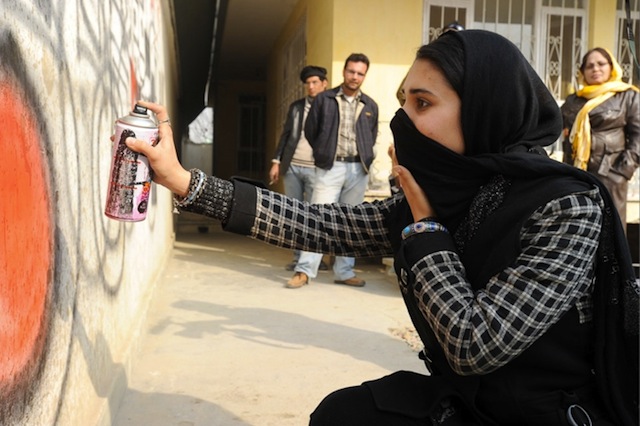
This is a guest post by Robin Grearson.
So here’s the deal. Complex asked Vandalog founder-leader RJ Rushmore to create a list for them, “50 Greatest Street Artists Right Now,” and that list came out this month. When I saw it I was surprised. Out of 50 names, the only women to make the cut were Faith47 and Swoon (and a few who make art with male partners).
Yes, I know that any person who makes up a list like that would come up with a different list. But the intro to the list read, “Public art has a whole new set of powerful voices. We’re celebrating those.” And 48 of the 50 entries on a list designed to celebrate powerful new voices were men’s voices. That’s not a lot of diversity. It’s not even a little diversity. I called out RJ for his selections, via Twitter.
We volleyed some names back and forth but ultimately my argument was not with his exclusion of any particular artist. In exchanges with RJ and others, the questions came up–as they tend to when women are breaking into boys’ clubs (politics, business, race-car driving, etc.): Should there be a separate list for women? (No.) Should there be a quota for women even if they’re “not as talented” as men? (No, but, false question.)
If I were RJ and knew the work of as many street artists as he does, I would start with my favorites, and probably run out of room just listing those artists. So I wouldn’t have to go looking under rocks to find artists I had never heard of before. If I were RJ, I might think that if there were any women (or men) doing truly great work, I would have heard about them by now. Except that’s not necessarily true, especially with women. For instance, RJ mentioned a few female artists he considered…but he didn’t put them on the list.
Consider that the most powerful and the most personal work is not necessarily going to resonate as strongly once it crosses gender lines, which is not a minor point. For instance, RJ said he’s not a fan of Olek. And I’m not a fan of Lush. And that’s how it works: women don’t end up on too many “greatest” lists, if the guys are the gatekeepers. And if they’re not on the lists, how does anyone hear about them? It’s a little like the axiom about getting a job: you can’t get hired till you have experience, but if you can’t get hired, where do you get experience?
After our exchange, RJ offered me an opportunity to write a post for Vandalog about women street artists, and I respect him for that. So here it is, there are five artists in particular who I think fit the Complex criteria but didn’t make the list. As I began researching the post, I asked around for referrals. Emails arrived all week with the names of talented women making great art all over the world. So as a deputized one-time Vandalog gatekeeper, I want people to know about established as well as emerging talents like Alice Mizrachi, Bastardilla, Bunny M, Cake, Elle, Fafi, Georgina Ciotti, Gilf!, Hyuro, Imminent Disaster, Lady Pink, Liliwenn, LMNOP, MISO, Miss Van, Sheryo, Shin Shin, Sofia Maldonado, Tati Suarez, Toofly, and Wing. Just to name a few. Because there are so many more.
The work they are making reflects their communities, it beautifies blighted areas, it makes us laugh, it breaks down gender barriers and smashes stereotypes and speaks out on behalf of women and children and parents and humanity. It is sensual and funny and simple and complex and symbolic and speaks of rights and wrongs and freedom. And these women have these strong, powerful, fierce, witty voices that we all need to hear. Why? Because they make images to express what we as viewers can’t articulate until we see their work. And then as it pierces our hearts and minds we say, simply: yes, that is exactly how I feel, too. But this is not because they are women. It is because they are artists.
After the jump, check out what these five world-class street artists who also happen to be women have been up to in 2012.
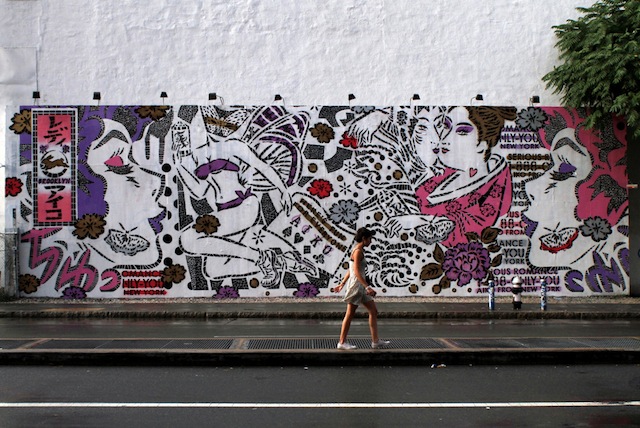
Lady Aiko has worked with Takashi Murakami, collaborated with Banksy, and helped found art-collective FAILE. She is a filmmaker, graphic designer and street artist who blends American contemporary art with a Japanese traditional aesthetic to create images that often explore femininity and female identity. The high-visibility corner of Houston Street and Bowery has been one of New York’s most exclusive curated walls since 2008. Os Gemeos, JR, Shepard Fairey and RETNA are just a few of the artists who have painted or installed artwork there, and this month, Aiko becomes the first female to paint the coveted spot.
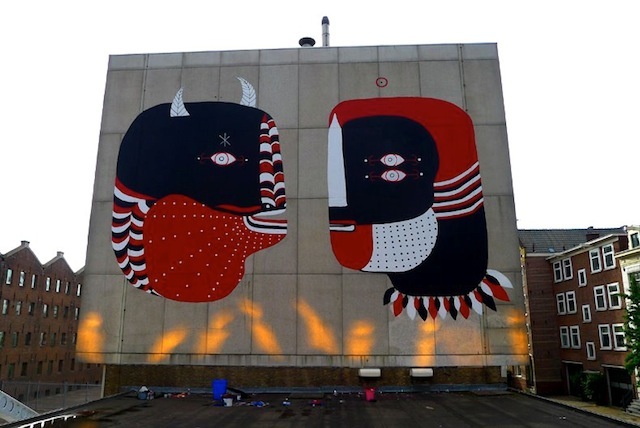
Your basic badass, Fefe is a street artist who paints around the world, a fine artist who shows in galleries from New York to Portugal, and a singer & dancer. Sao Paulo, Brazil, and Madrid, Spain are home bases for Fefe, whose colorful monsters express the feelings and longings hidden in darker parts of ourselves. Last year the Nike Foundation commissioned Fefe to create artwork for The Girl Effect, an organization trying to end poverty through “helping girls help themselves.” This month, Fefe completed a huge mural in Amsterdam featuring two characters, Brazilian Indians wearing animal masks, as part of a local protest against big utility companies.

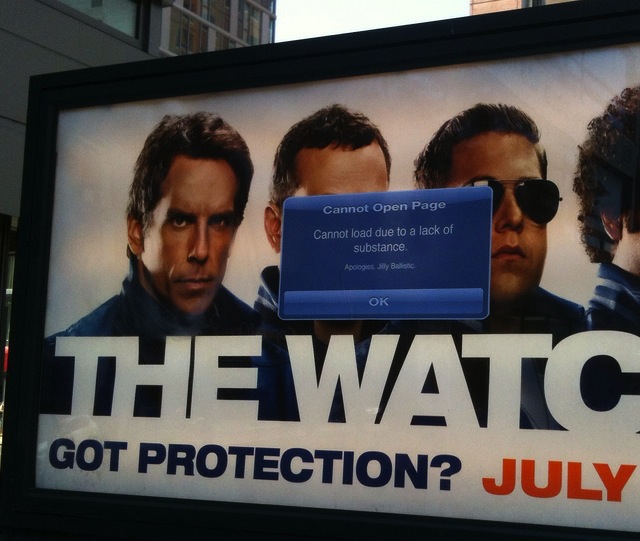
The world discovered Jilly Ballistic this summer. Jilly’s been leaving clever “ad bombs” that resemble Mac OS error messages around NYC’s subways, and everyone from art blogs to major media have been talking about them (Reddit, Laughing Squid, Juxtapoz, Buzzfeed and Mashable, among many others). Jilly also puts up historical photos in the subway that are custom designed to fit their environments—environments which include not just platform walls but inside train cars on seats, on windows, over ads. Her work is being shared and reblogged and Instagrammed because it’s gratifying–er, relatable. The error messages are witty and fresh and capture what most of us think when we see bad movie posters and dumb ads. Yet even with the name “Jilly,” press sometimes describes her as a “he.” What, girls can’t make art about computers? But they do.
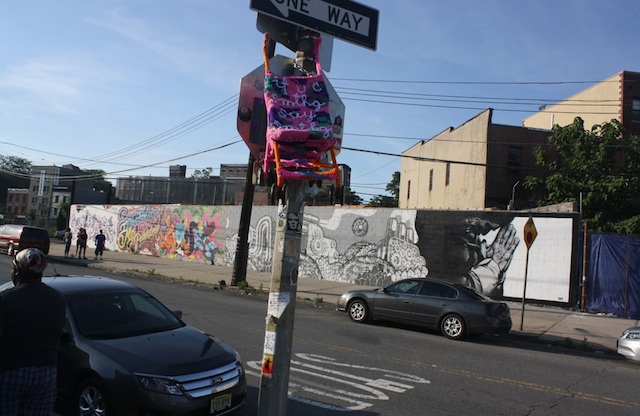
Olek did not invent crochet or street art, nor was she the first artist to bring the two together. But Olek’s style and her passion have made her the one we associate with yarn-bombing, and with Olek, a home-based, traditionally female craft of crochet hit the big time as street art. Not everybody likes it, not everyone gets it. That’s cool. I’m not sure what she was doing hanging up a crocheted baby carriage featuring the words “If You See Something, Say Something” at Welling Court. But there is no denying Olek has broken new ground. Or that she is one of the year’s most visible artists. Or that she has opened doors for everyone—by expanding our ideas about what “street art” needs to look like, and what materials we can make it with. She’s currently part of a “40 Under 40: Craft Futures” exhibit that just opened at the Smithsonian American Art Museum.
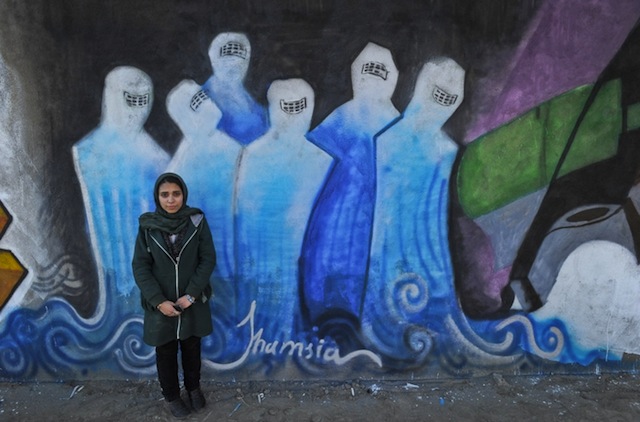
Earlier this year The Guardian called Shamsia Hassani “probably her country’s first serious graffiti artist,” but Shamsia didn’t pick up her first spray can till December 2010. To measure a street artist’s talent, many say you have to consider context. If you are a young woman who wants to paint in Kabul, Afghanistan, you can’t just go down to the corner store and pick up some Krink markers and a few cans of Montana Black, Montana Gold, or Montana anything and start learning as you go. Painting outside means going outside, which even for a woman wearing a burqa means getting sexually harassed about exposed hands and ankles. Also, there are landmines to consider. Still, Shamsia is committed to creating more art in Kabul streets, believing it’s a critical step to helping the city rebuild. “If people see an artwork,” she told The Guardian, “it will perhaps only cause a small shock to their mind, but that can grow and grow.” Hope so.
Photos by Luna Park and Rhiannon Platt and courtesy of Fefe Talavera, Jilly Ballistic and Combat Comms
